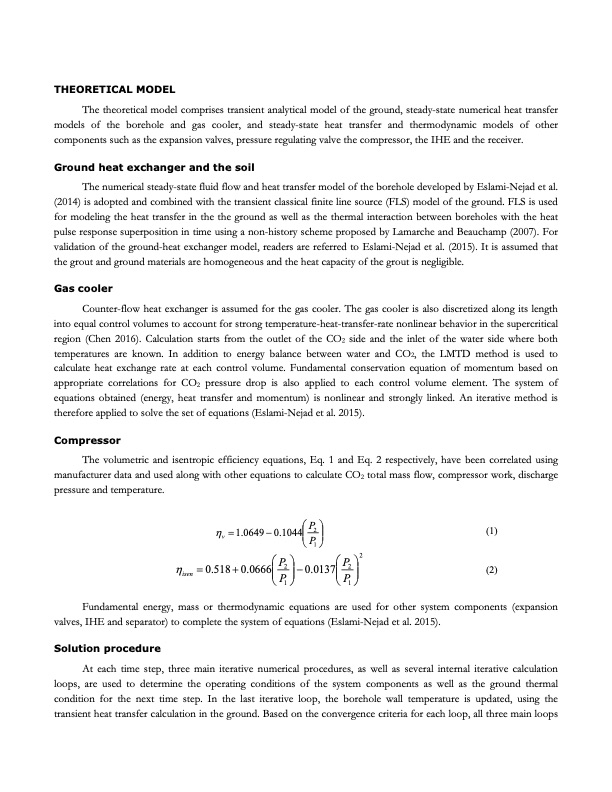
PDF Publication Title:
Text from PDF Page: 003
THEORETICAL MODEL The theoretical model comprises transient analytical model of the ground, steady-state numerical heat transfer models of the borehole and gas cooler, and steady-state heat transfer and thermodynamic models of other components such as the expansion valves, pressure regulating valve the compressor, the IHE and the receiver. Ground heat exchanger and the soil The numerical steady-state fluid flow and heat transfer model of the borehole developed by Eslami-Nejad et al. (2014) is adopted and combined with the transient classical finite line source (FLS) model of the ground. FLS is used for modeling the heat transfer in the the ground as well as the thermal interaction between boreholes with the heat pulse response superposition in time using a non-history scheme proposed by Lamarche and Beauchamp (2007). For validation of the ground-heat exchanger model, readers are referred to Eslami-Nejad et al. (2015). It is assumed that the grout and ground materials are homogeneous and the heat capacity of the grout is negligible. Gas cooler Counter-flow heat exchanger is assumed for the gas cooler. The gas cooler is also discretized along its length into equal control volumes to account for strong temperature-heat-transfer-rate nonlinear behavior in the supercritical region (Chen 2016). Calculation starts from the outlet of the CO2 side and the inlet of the water side where both temperatures are known. In addition to energy balance between water and CO2, the LMTD method is used to calculate heat exchange rate at each control volume. Fundamental conservation equation of momentum based on appropriate correlations for CO2 pressure drop is also applied to each control volume element. The system of equations obtained (energy, heat transfer and momentum) is nonlinear and strongly linked. An iterative method is therefore applied to solve the set of equations (Eslami-Nejad et al. 2015). Compressor The volumetric and isentropic efficiency equations, Eq. 1 and Eq. 2 respectively, have been correlated using manufacturer data and used along with other equations to calculate CO2 total mass flow, compressor work, discharge pressure and temperature. P ηv = 1.0649 − 0.1044 2 (1) (2) 1 ηisen = 0.518 + 0.0666 2 − 0.0137 2 P P 2 1 1 P PP Fundamental energy, mass or thermodynamic equations are used for other system components (expansion valves, IHE and separator) to complete the system of equations (Eslami-Nejad et al. 2015). Solution procedure At each time step, three main iterative numerical procedures, as well as several internal iterative calculation loops, are used to determine the operating conditions of the system components as well as the ground thermal condition for the next time step. In the last iterative loop, the borehole wall temperature is updated, using the transient heat transfer calculation in the ground. Based on the convergence criteria for each loop, all three main loopsPDF Image | Direct expansion ground source heat pump using R744

PDF Search Title:
Direct expansion ground source heat pump using R744Original File Name Searched:
oksd_igshpa_2017_Nejad.pdfDIY PDF Search: Google It | Yahoo | Bing
CO2 Organic Rankine Cycle Experimenter Platform The supercritical CO2 phase change system is both a heat pump and organic rankine cycle which can be used for those purposes and as a supercritical extractor for advanced subcritical and supercritical extraction technology. Uses include producing nanoparticles, precious metal CO2 extraction, lithium battery recycling, and other applications... More Info
Heat Pumps CO2 ORC Heat Pump System Platform More Info
| CONTACT TEL: 608-238-6001 Email: greg@infinityturbine.com | RSS | AMP |